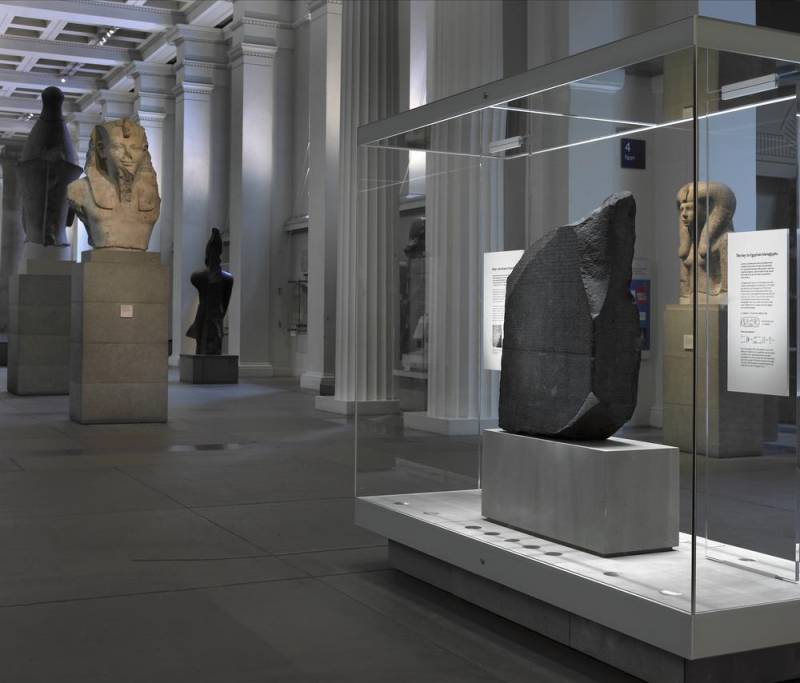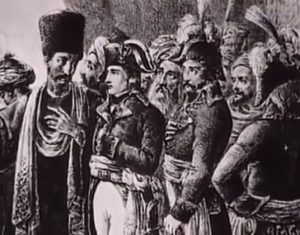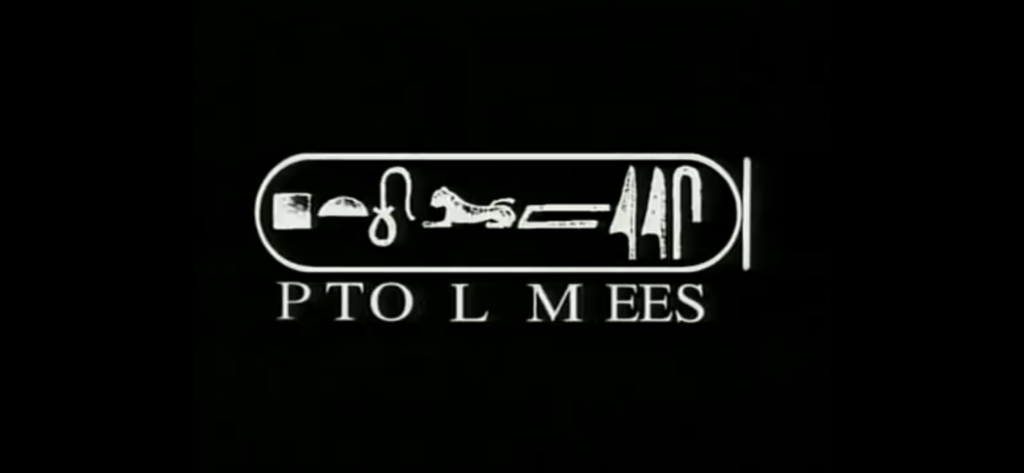
I first heard of a land called Egypt in my grade school years at St. Bonaventure’s in Hyderabad. It was a land where the Pharaohs had ruled and built monuments that had survived for four millennia.
Years later, at the University of Karachi I read about the Rosetta Stone and was intrigued how a single slab of granite had helped decipher the language of ancient Egypt.
Decades later while touring the Rosicrucian Museum in San Jose, California, I finally set eyes on the Rosetta Stone. Alas, it was a replica. It was only in 1989 that I got to see the original while touring the British Museum in London.
There was a time when the sun never set on the British Empire. The British collected treasures from all over the globe and proudly displayed them at the British Museum in London. Today, the visitor will find statues, thrones, armor, and objects of art beautifully displayed there in several galleries.
Surprisingly, the most prized collection and the one that draws the most crowds is the Rosetta Stone, an irregular shaped, nondescript slab weighing 1,500 pounds with undecipherable text written over it in three scripts.
 On the 1st of July, 1798, Napoleon Bonaparte, the emperor of the French, set foot on Egyptian soil. He had come to Alexandria with the primary objective of containing Britain’s influence in the Middle East. But he also had a secondary objective. Napoleon was a historian who was fascinated with Egypt. In his entourage there were several archaeologists.
On the 1st of July, 1798, Napoleon Bonaparte, the emperor of the French, set foot on Egyptian soil. He had come to Alexandria with the primary objective of containing Britain’s influence in the Middle East. But he also had a secondary objective. Napoleon was a historian who was fascinated with Egypt. In his entourage there were several archaeologists.
They began to scrounge the country for antiquities, hoping to dive into the history of that fabled land by making new discoveries. Egypt was home to the Great Pyramids at Giza, the only surviving member of the Seven Ancient Wonders of the World. Countless other treasures lay in cities such as Luxor, Saqqara and Alexandria. Several of the monuments were decorated with undecipherable inscriptions. The statues and obelisks of the Pharaohs had stood like silent sentinels in the sands of Egypt for two millennia.
On July 15, 1799, Napoleon’s army engineers stumbled onto an unusual stone while digging the foundations of an addition to a fort near the town of Rashid (Rosetta) in the Nile Delta. They immediately knew it was an object of great significance.
In the meantime, the British had not taken lightly to Napoleon’s invasion of France. A British fleet commanded by Admiral Nelson was sent to defeat the French navy and evict the French. It succeeded, forcing Napoleon to flee to France.
On Napoleon’s defeat, the Rosetta Stone became the property of the British along with other antiquities that the French had found. It was shipped to England and arrived in Portsmouth in February 1802. Soon thereafter it was put on display in the British Museum.
 Hieroglyphs had stopped being used around the end of the 4th century AD. In due course of time, no one knew how to read them. The Rosetta Stone had been created in 197 BC. On it are written three languages: hieroglyphics, used by the priests; Demotic, used by the common people; and ancient Greek. Using the Greek inscription on the stone as an enabler, Thomas Young, an English physicist, devoted a summer to deciphering the code. He found that some of the hieroglyphs on the Rosetta Stone were the sounds of a royal name, Ptolemy.
Hieroglyphs had stopped being used around the end of the 4th century AD. In due course of time, no one knew how to read them. The Rosetta Stone had been created in 197 BC. On it are written three languages: hieroglyphics, used by the priests; Demotic, used by the common people; and ancient Greek. Using the Greek inscription on the stone as an enabler, Thomas Young, an English physicist, devoted a summer to deciphering the code. He found that some of the hieroglyphs on the Rosetta Stone were the sounds of a royal name, Ptolemy.
A French scholar, Jean-Francois Champollion, dug deeper into the texts on the stone and concluded that the hieroglyphs recorded the sound of the Egyptian language. This was a breakthrough in understanding ancient Egyptian language and culture. Champollion pieced together the alphabet of hieroglyphs that was used to write the names of non-Egyptian rulers.
He announced his discovery on September 27, 1822. The audience included his English rival Thomas Young, who was also trying to decipher Egyptian hieroglyphs. Young had mixed feelings about Champollion’s discovery. One the one hand, he was elated. On the other hand, he was depressed at not being given any credit.
Champollion made a second breakthrough in 1824 when he realized that the alphabetic signs were used not only for foreign names, but also for Egyptian names. In the end, it was his knowledge of the Coptic language, which derived from ancient Egyptian, which allowed him to unravel the mysteries of the hieroglyphic inscriptions.
Inscribed on the Rosetta Stone is a decree passed by a council of priests affirming the regal stature of the 13-year-old Ptolemy V. He was descended from a long line of rulers dating back to the great Ptolemy, who had been a general in the army of Alexander the Great and who had inherited Egypt on Alexander’s death.
The Ptolemies did not bother to learn Egyptian and made Greek the official language. Their capital city, Alexandria, was second only to Rome in the classical world. Its library housed the best collection of books in the world and the Pharos Lighthouse was regarded as one of the seven ancient wonders of the world.
Scholars suggest that the development of the modern Roman alphabet hearkens back to Egyptian hieroglyphics, which were cumbersome and difficult to learn. Only the high priests could read them. A simplified version was developed by the Pharaohs to communicate with their slaves, who were largely prisoners of wars drawn from neighboring countries.
When the slaves eventually returned home, they took the simpler version of the Egyptian hieroglyphics with them. The simpler alphabet spread through the Middle East and became the new writing system, finding expression in Arabic and Hebrew characters, morphing into the language of the Phoenicians, and eventually leading to the Greek and Roman alphabets.
In one of those ironies that abound in history, while Napoleon lost Egypt to the British, he is remembered as the man who opened the door understanding to our understanding of life in ancient Egypt. Similarly, while the Rosetta Stone may sit in the British Museum, the credit for decoding its inscriptions belongs to a Frenchman.
In 1996 I visited Egypt for the first time, toured Cairo, Memphis, Saqqara and Alexandria, and imagined life under the Pharaohs, the last one of whom was Cleopatra. She who would earn a permanent place in history by befriending first Julius Caesar and then Mark Antony.
In 2009 I returned to view the monuments a second time but forgot to visit Rosetta where the most famous stone in the world was found. That will have to await a third visit. In the meantime, I have made a virtual visit via this video.
Years later, at the University of Karachi I read about the Rosetta Stone and was intrigued how a single slab of granite had helped decipher the language of ancient Egypt.
Decades later while touring the Rosicrucian Museum in San Jose, California, I finally set eyes on the Rosetta Stone. Alas, it was a replica. It was only in 1989 that I got to see the original while touring the British Museum in London.
There was a time when the sun never set on the British Empire. The British collected treasures from all over the globe and proudly displayed them at the British Museum in London. Today, the visitor will find statues, thrones, armor, and objects of art beautifully displayed there in several galleries.
Surprisingly, the most prized collection and the one that draws the most crowds is the Rosetta Stone, an irregular shaped, nondescript slab weighing 1,500 pounds with undecipherable text written over it in three scripts.
 On the 1st of July, 1798, Napoleon Bonaparte, the emperor of the French, set foot on Egyptian soil. He had come to Alexandria with the primary objective of containing Britain’s influence in the Middle East. But he also had a secondary objective. Napoleon was a historian who was fascinated with Egypt. In his entourage there were several archaeologists.
On the 1st of July, 1798, Napoleon Bonaparte, the emperor of the French, set foot on Egyptian soil. He had come to Alexandria with the primary objective of containing Britain’s influence in the Middle East. But he also had a secondary objective. Napoleon was a historian who was fascinated with Egypt. In his entourage there were several archaeologists.They began to scrounge the country for antiquities, hoping to dive into the history of that fabled land by making new discoveries. Egypt was home to the Great Pyramids at Giza, the only surviving member of the Seven Ancient Wonders of the World. Countless other treasures lay in cities such as Luxor, Saqqara and Alexandria. Several of the monuments were decorated with undecipherable inscriptions. The statues and obelisks of the Pharaohs had stood like silent sentinels in the sands of Egypt for two millennia.
On July 15, 1799, Napoleon’s army engineers stumbled onto an unusual stone while digging the foundations of an addition to a fort near the town of Rashid (Rosetta) in the Nile Delta. They immediately knew it was an object of great significance.
In the meantime, the British had not taken lightly to Napoleon’s invasion of France. A British fleet commanded by Admiral Nelson was sent to defeat the French navy and evict the French. It succeeded, forcing Napoleon to flee to France.
On Napoleon’s defeat, the Rosetta Stone became the property of the British along with other antiquities that the French had found. It was shipped to England and arrived in Portsmouth in February 1802. Soon thereafter it was put on display in the British Museum.
 Hieroglyphs had stopped being used around the end of the 4th century AD. In due course of time, no one knew how to read them. The Rosetta Stone had been created in 197 BC. On it are written three languages: hieroglyphics, used by the priests; Demotic, used by the common people; and ancient Greek. Using the Greek inscription on the stone as an enabler, Thomas Young, an English physicist, devoted a summer to deciphering the code. He found that some of the hieroglyphs on the Rosetta Stone were the sounds of a royal name, Ptolemy.
Hieroglyphs had stopped being used around the end of the 4th century AD. In due course of time, no one knew how to read them. The Rosetta Stone had been created in 197 BC. On it are written three languages: hieroglyphics, used by the priests; Demotic, used by the common people; and ancient Greek. Using the Greek inscription on the stone as an enabler, Thomas Young, an English physicist, devoted a summer to deciphering the code. He found that some of the hieroglyphs on the Rosetta Stone were the sounds of a royal name, Ptolemy.A French scholar, Jean-Francois Champollion, dug deeper into the texts on the stone and concluded that the hieroglyphs recorded the sound of the Egyptian language. This was a breakthrough in understanding ancient Egyptian language and culture. Champollion pieced together the alphabet of hieroglyphs that was used to write the names of non-Egyptian rulers.
He announced his discovery on September 27, 1822. The audience included his English rival Thomas Young, who was also trying to decipher Egyptian hieroglyphs. Young had mixed feelings about Champollion’s discovery. One the one hand, he was elated. On the other hand, he was depressed at not being given any credit.
Champollion made a second breakthrough in 1824 when he realized that the alphabetic signs were used not only for foreign names, but also for Egyptian names. In the end, it was his knowledge of the Coptic language, which derived from ancient Egyptian, which allowed him to unravel the mysteries of the hieroglyphic inscriptions.
Inscribed on the Rosetta Stone is a decree passed by a council of priests affirming the regal stature of the 13-year-old Ptolemy V. He was descended from a long line of rulers dating back to the great Ptolemy, who had been a general in the army of Alexander the Great and who had inherited Egypt on Alexander’s death.
The Ptolemies did not bother to learn Egyptian and made Greek the official language. Their capital city, Alexandria, was second only to Rome in the classical world. Its library housed the best collection of books in the world and the Pharos Lighthouse was regarded as one of the seven ancient wonders of the world.
Scholars suggest that the development of the modern Roman alphabet hearkens back to Egyptian hieroglyphics, which were cumbersome and difficult to learn. Only the high priests could read them. A simplified version was developed by the Pharaohs to communicate with their slaves, who were largely prisoners of wars drawn from neighboring countries.
When the slaves eventually returned home, they took the simpler version of the Egyptian hieroglyphics with them. The simpler alphabet spread through the Middle East and became the new writing system, finding expression in Arabic and Hebrew characters, morphing into the language of the Phoenicians, and eventually leading to the Greek and Roman alphabets.
In one of those ironies that abound in history, while Napoleon lost Egypt to the British, he is remembered as the man who opened the door understanding to our understanding of life in ancient Egypt. Similarly, while the Rosetta Stone may sit in the British Museum, the credit for decoding its inscriptions belongs to a Frenchman.
In 1996 I visited Egypt for the first time, toured Cairo, Memphis, Saqqara and Alexandria, and imagined life under the Pharaohs, the last one of whom was Cleopatra. She who would earn a permanent place in history by befriending first Julius Caesar and then Mark Antony.
In 2009 I returned to view the monuments a second time but forgot to visit Rosetta where the most famous stone in the world was found. That will have to await a third visit. In the meantime, I have made a virtual visit via this video.
